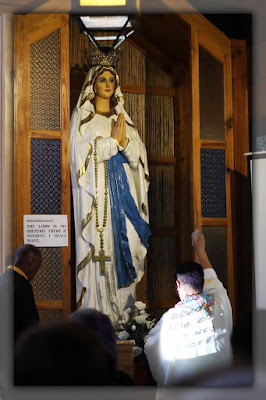Nuestra Señora de Lourdes de Baguio - The Lady of the famed Hill Grotto
 |
| The cast replica of the original image of Our Lady of Lourdes of Baguio that is currently enshrined at the Grotto |
This landmark became part of the every tourists and pilgrims' itinerary to get away from the noise of the famed city and to make the sacrifice of climbing the 252 steps leading to the Grotto to be in state of silence and ask the help of the Blessed Mother for her guidance in one's journey in life.
The image
The image of Our Lady of Lourdes of the Baguio grotto once again adheres to the proper iconography of the Virgin as seen by its visionary St. Bernadette Soubirous. St. Bernadette describes the Virgin in this manner:
"She has the appearance of a young girl of sixteen or seventeen. She is dressed in a white robe, girdled at the waist with a blue ribbon, which flows down all along her robe. She wears upon her head a veil which is also white; this veil gives just a glimpse of her hair then falls down at the back below her below her waist.
Her feet are bare but covered by the last folds of her robe except at the point where a yellow rose shines upon each of them. She holds on her right arm a Rosary of white beads with a chain of gold shining like the two roses on her feet."
 |
| The original image of Nuestra Señora de Lourdes de Baguio by Isabelo Tampaingco now enshrined at the recently constructed chapel |
The Origin of the Baguio Grotto
The century-old Lourdes Grotto, was built near the Mirador Hill Jesuit Villa in 1907 at the initiative of Fr. José Algue, S.J., then director of the Manila Observatory. The grotto was made of limestone, probably gathered on Mirador Hill, and was built, in slow stages, by the Jesuits. The stairway then made of stones, from the grotto to the foot of the hills, was completed five years later and it was covered with cement. The beautiful statue of Nuestra Señora de Lourdes was carved by the famed santero Isabelo Tampingco in 1913 which posses exquisite beauty.
Since the establishment of the Grotto at Mirador Hill, it instantly became a national pilgrimage site where pilgrims would climb the 252 steps leading to the Grotto to pray before the beautiful image of Our Lady of Lourdes.
In the recent years, the Grotto shrine developed to accommodate the increasing number of pilgrims, devotees and tourists who are coming to the site from its maintenance and safety measures. A chapel was recently constructed so that masses can be held and it is in the new chapel that the original image of Nuestra Señora de Lourdes de Baguio that was carved by Tampingco is currently enshrined for preservation and a cast replica of the image is currently enthroned at the Grotto.
 |
| The Grotto Shrine and its steps |
The Grotto shrine continues to be one of the most visited shrines in the farther Northern Luzon alongside Piat Basilica Minore in Cagayan Valley and Guibang Shrine in Isabela. It is interesting to know and see that this humble Grotto will be a place of solace, peace and consolation amidst the chaos and busy life of Baguio City.
A pilgrimage to a sacred destination have the purpose to atone one’s sins, living a spiritual experience, imploring graces, and even miracles with the ultimate goal of drawing closer to God. For that reason, a pilgrimage should “cost” something in terms of self-imposed hardships that require a level of sacrifice - in this case is climbing the 252 steps.
Pope Emeritus Benedict XVI once gave a beautiful definition of pilgrimage. “To go on pilgrimages is not simply to visit a place to admire its treasures of nature, art, or history. To go on pilgrimage really means to step out of ourselves in order to encounter God where he has revealed himself, where his grace has shone with particular splendor and produced rich fruits of conversion and holiness among those who believe.”
If one will plan to visit the famed hill Grotto, take time to pause and reflect while taking the steep steps and once you reached the grotto, the Blessed Mother is waiting for us, smiling, just like what St. Bernadette saw in her visions centuries ago. There, we can confide to her all our troubles, seek her help and give thanks to God for the all the graces through so that when one comes from this experience, one can feel refreshed and renewed in body and in spirit.
References:
Castro, Alex, "Retro Santo: Lourdes Grotto of Baguio" Retrieved from http://andalltheangelsandsaints.blogspot.com/2011/02/52-retro-santo-lourdes-grotto-of-baguio.html on February 5, 2020.
Feleon, Marge, "Why I Didn’t Have Any “Fun” on My Marian Pilgrimage", 2018, Retrieved from https://margefenelon.com/6366/why-i-didnt-have-any-fun-on-my-marian-pilgrimage/ on February 6, 2020.
Layug, Benjie, "Our Lady of Lourdes Grotto (Baguio City, Benguet)" retrieved from http://benjielayug.com/2019/01/our-lady-of-lourdes-grotto-baguio-city-benguet.html on February 5, 2020.
LeBlanc, Marie FSSP,, "Marian Apparitions and Devotions", Pauline Publications, New York, USA, 1995.
Photos:
Daquioag, Michael Angelo - Buen Viaje PH
Special thanks to Mr. Michael Angelo Daquioag for the recent photographs of Nuestra Señora de Lourdes de Baguio.
+AM+DG+





Comments
Post a Comment